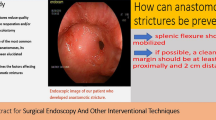Abstract
Anastomotic stenosis after colorectal surgery is usually considered low-rate complication and often is under-reported in most studies. Few data are available on management strategies. The aim of the study was to assess the prevalence of stenosis after stapled colorectal anastomosis, performed either in elective or emergent setting, for benign or malignant disease, and to evaluate treatment profiles. This retrospective study was a survey conducted in a large Italian North-Eastern area including three regions (Triveneto), over a 12-month period (January–December 2015). Patients’ characteristics and surgical technique details were recorded, along with data on the prevalence of stenosis and its treatment. Patients with mid or low rectal resection and/or neoadjuvant chemo-radio therapy and/or diverting stoma were excluded. The study was promoted by the Italian Association of Hospital Surgeons (ACOI) and the Society of Surgeons of the Triveneto Region. Twenty-eight surgical units were enrolled in the survey, accounting for over 1400 patients studied. Fifty percent of the units performed laparoscopically > 70% of the colorectal resections and 7.5% of the procedures were emergent. Less than 60% of the units planned regular endoscopic follow-up after colorectal resection. Anastomotic stricture was recorded in 2% of the patients; 88% of the stenoses were diagnosed within 6 months from surgery. Only one anastomotic stricture required re-do surgery. The CANSAS study confirms that colorectal anastomotic stenosis is low-rate—but still present—complication. Treatment strategies vary according to surgeons’ and endoscopists’ preferences. Commonly endoscopic dilatation is preferred, but re-do surgery is required in some cases.
Similar content being viewed by others
References
Luchtefeld MA, Milsom JW, Senagore A, Surrell JA, Mazier WP (1989) Colorectal anastomotic stenosis. Results of a survey of the ASCRS membership. Dis Colon Rectum 32:733–736
Bannura GC, Cumsille MA, Barrera AE, Contreras JP, Melo CL, Soto DC (2004) Predictive factors of stenosis after stapled colorectal anastomosis: prospective analysis of 179 consecutive patients. World J Surg 28:921–925
Polese L, Vecchiato M, Frigo AC, Sarzo G, Cadrobbi R, Rizzato R, Bressan A, Merigliano S (2012) Risk factors for colorectal anastomotic stenoses and their impact on quality of life: what are the lessons to learn? Colorectal Dis 14:e124–e128. https://doi.org/10.1111/j.1463-1318.2011.02819
Ambrosetti P, Francis K, De Peyer R, Frossard J-L (2008) Colorectal anastomotic stenosis after elective laparoscopic sigmoidectomy for diverticular disease: a prospective evaluation of 68 patients. Dis Colon Rectum 51:1345–1349
Hiranyakas A, Da Silva G, Denoya P, Shawki S, Wexner SD (2013) Colorectal anastomotic stricture: is it associated with inadequate colonic mobilization? Tech Coloproctol 17:371–375
Davis B, Rivadeneira D (2013) Complications of colorectal anastomoses. Leaks, strictures and bleeding. Surg Clin N Am 93:61–87
Pahlman I, Glimelius B, Frykholm G (1989) Ischaemic strictures in patients treated with a low anterior resection and perioperative radiotherapy for rectal carcinoma. Br J Surg 76:605–606
Waxman BP, Ramsay AH (1986) The effect of stapler diameter and proximal colostomy on narrowing at experimental circular stapled large bowel anastomosis. Aust N Z J Surg 56:797–801
Matos D, Atallah AN, Castro AA, Lustosa S (2001) Stapled versus handsewn methods for colorectal anastomosis surgery. Cochrane Database Syst Rev 3:CD003144
Di Giorgio P, De Luca L, Rivellini G, Sorrentino E, D’Amore E, De Luca B (2004) Endoscopic dilatation of benign colorectal anastomotic stricture after low anterior resection: a prospective comparison study of two balloon types. Gastrointest Endosc 60:347–350
Forshaw MJ, Maphosa G, Sankararajah D, Parker MC, Stewart M (2006) Endoscopic alternatives in managing anastomotic strictures of the colon and rectum. Tech Coloproctol 10:21–27
Brandimarte G, Tursi A, Gasbarrini G (2000) Endoscopic treatment of benign anastomotic colorectal stenosis with electrocautery. Endoscopy 32:461–463
Suchan KL, Muldner A, Manegold BC (2003) Endoscopic treatment of postoperative colorectal anastomotic strictures. Surg Endosc 17:1110–1113
Schlegel RD, Dehni N, Parc R, Caplin S, Tiret E (2001) Results of reoperations in colorectal anastomotic strictures. Dis Colon Rectum 44:1464–1468
Fasth S, Hedlund H, Svaninger G, Hulten L (1982) Autosuture of low colorectal anastomosis. Acta Chir Scand 148:535–539
Fegiz G (1983) ANgelini L, Bezzi M. Rectal cancer: restorative surgery with EEA stapling device. Int Surg 6:13–18
Swenson O, Idriss FS (1966) Excision of rectal stricture with end-to-end anastomosis. Arch Surg 93:54–58
Acknowledgements
Collaborators of the CANSAS study working group (Colorectal ANastomotic Stenosis After Surgery). S Vigna, A Mazzeo, D Coco, F Agresta, E Finotti, M Antoniutti, S Carnio, A Elio, M Brunelli, G Ruffo, E Bertocchi, D Parini, L Losacco, F Poli, G Santoro, M Massani, C Ruffolo, E Cian, L Zanatta, M Genna, A Ballarin, M Rebonato, M Fontana, G Moretto, H Impellizzeri, R Merenda, G Margani, S Merigliano, N Baldan, P Ubiali, A Braini, A Balani, M Kosuta, A Infantino, G Giacomel, G Armatura, S Patauner, N de Manzini, S Palmisano, M Sorrentino, M Brizzolari, C Belluco, M Olivieri, E Lauro, G Scudo, P Valduga, A Brolese, G Pignata, J Andreucetti, A Caruso, F Zappalà.
Funding
There was no funding source for this paper.
Author information
Authors and Affiliations
Consortia
Corresponding author
Ethics declarations
Conflict of interest
Drs. Alberto Sartori, Maurizio De Luca, Valentino Fiscon, Mauro Frego, the CANSAS study working group and Giuseppe Portale have no conflict of interest to disclose.
Ethical approval
The study was conducted according to the Helsinki Declaration. The study was approved by the local Ethics Committee.
Informed consent
Patients gave their consent to have their data collected for scientific purposes.
Additional information
Collaborators of the CANSAS study working group (Colorectal ANastomotic Stenosis After Surgery) are given in the acknowledgements section.
Rights and permissions
About this article
Cite this article
Sartori, A., De Luca, M., Fiscon, V. et al. Retrospective multicenter study of post-operative stenosis after stapled colorectal anastomosis. Updates Surg 71, 539–542 (2019). https://doi.org/10.1007/s13304-018-0575-8
Received:
Accepted:
Published:
Issue Date:
DOI: https://doi.org/10.1007/s13304-018-0575-8




